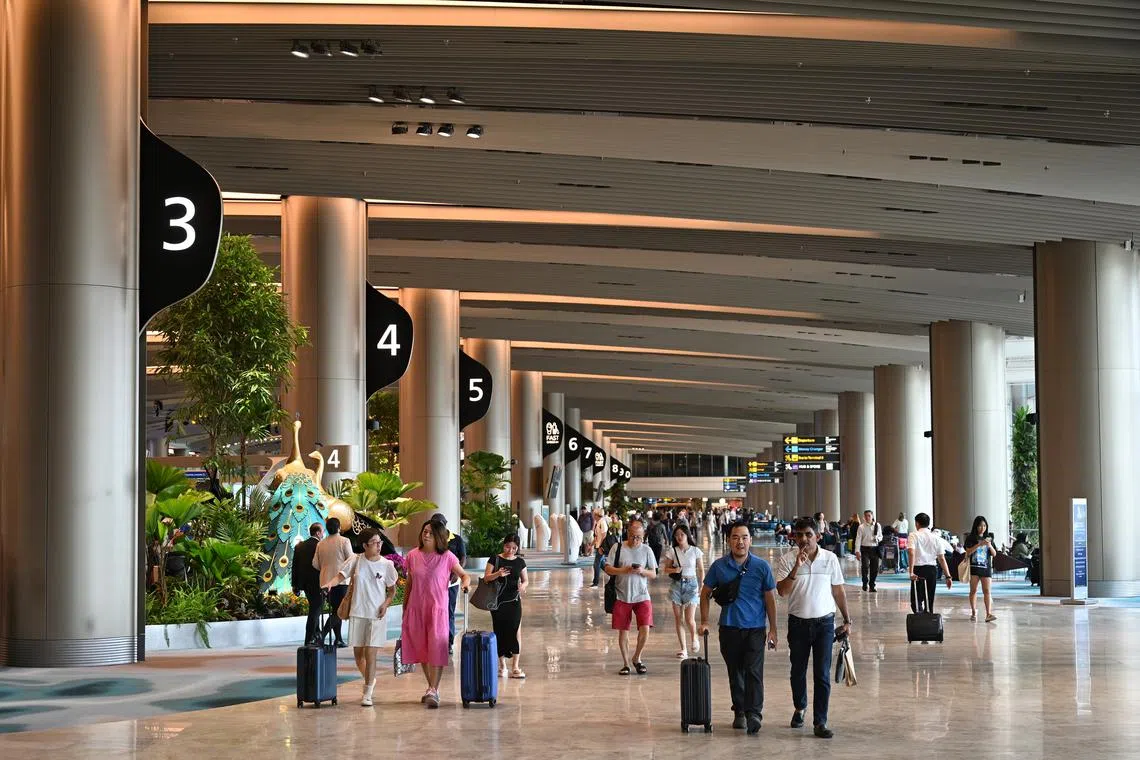4.7b people expected to travel by air in 2024, about 4% more than pre-pandemic levels: Iata
Sign up now: Get ST's newsletters delivered to your inbox

The aviation industry’s revenues are expected to rise to a record US$964 billion in 2024, from a better-than-expected US$896 billion in 2023.
ST PHOTO: SHINTARO TAY
Follow topic:
GENEVA - Airlines are expected to see higher demand for air travel in 2024, with 4.7 billion people forecast to travel.
This will be a historic high and about 4 per cent more than the 4.5 billion people who flew in 2019 before the Covid-19 pandemic wreaked havoc on air travel.
Releasing these projections on Dec 6 at its global media day in Geneva, Switzerland, the International Air Transport Association (Iata) noted that the aviation industry is projected to reach a net profit of US$25.7 billion (S$34.4 billion) in 2024 as it continues recovering from major losses incurred during the pandemic.
Iata is a trade association representing 320 airlines that collectively make up 83 per cent of global air traffic.
The industry body forecast that the net profitability of airlines will largely stabilise in 2024, but will continue lagging behind the cost of capital on a global level.
The aviation industry’s revenues are expected to rise 7.6 per cent to a record US$964 billion in 2024, from a better-than-expected US$896 billion in 2023. This will be faster than the 6.9 per cent growth in expenses in 2024 totalling US$914 billion, said Iata.
Iata director-general Willie Walsh said the projected 2024 net profit of US$25.7 billion is a tribute to the industry’s resilience, considering the major losses that it shouldered in recent years. Net profit is expected to come in at US$23.3 billion in 2023.
Mr Walsh described the industry’s recovery as “impressive” but said its projected net profit margin for 2024 of 2.7 per cent is “far below what investors in almost any other industry would accept”. Net profit margin is a measure of how much net income or profit is generated as a percentage of revenue.
Operating profit is expected to increase by 21.1 per cent to US$49.3 billion in 2024, but the industry’s net profit margin will rise at less than half this pace, mostly owing to higher interest rates expected in 2024.
Putting these figures in perspective, Mr Walsh, who was chief executive of British Airways, noted that airlines will retain just US$5.45 for every passenger carried. This, he said, is enough to buy a “basic grande latte at a London Starbucks” and is “far too little” for the aviation industry, on which 3.5 per cent of global gross domestic product depends.
He cited onerous regulations, a large number of players in the industry, high infrastructural costs, and a supply chain populated by a small number of companies as factors pulling down airline profits.
Raising the problem of airport charges – fees paid by airlines for the use of airport facilities – as an example, Mr Walsh said many airports struggle to act in a commercial fashion as they are controlled by monopolies with little incentive to perform efficiently in the interests of airlines and consumers.
On top of that, problems such as global economic strains, higher oil prices due to the Russia-Ukraine and Israel-Hamas wars, and regulatory risks could also weaken the aviation industry’s profitability.
Iata said carriers in North America, Europe and the Middle East are projected to post net profits in 2023, with Asia-Pacific airlines joining the fray in 2024. Those in Latin America and Africa are expected to incur losses.
Iata director of policy and economics Andrew Matters said passenger traffic for the Asia-Pacific will “certainly catch up” in 2024, moving ahead of all the other regions with a projected 127 per cent recovery over 2019 levels.
The association said airlines in the Asia-Pacific are forecast to make a net profit of US$1.1 billion in 2024, an improvement from an expected net loss of US$100 million in 2023.
The recovery so far has been subdued for various reasons.
First, the removal of China’s border restrictions
Second, domestic air travel in the Asia-Pacific has already recovered beyond pre-pandemic levels, Mr Walsh said.
Third, delays in the delivery of new wide-body jets that affect airlines not just in the Asia-Pacific but also globally will ease gradually only in 2024, he added.
For their part, travellers can expect airfares to continue rising, in line with increasing expenses, particularly for oil.
Even so, Iata’s data shows that competition in the industry continued bringing price benefits to consumers, with the average return airfare worldwide – after being adjusted for inflation – in 2023 expected to be US$254, 19 per cent lower than the average fare of US$315 in 2019.
Looking ahead, Mr Walsh said the increased accessibility of air travel for passengers with disabilities is both a responsibility and a business opportunity for the industry. Iata has kick-started this effort by developing a set of principles in 2019 and will use it as the basis for international initiatives in the future.
He said: “From 2024, the outlook indicates that we can expect more normal growth patterns for both passenger and cargo.”
Cargo yields, or average fares paid by customers to transport freight and mail, are expected to continue dipping towards pre-pandemic levels, according to Iata’s projections. Yields declined 32.2 per cent in 2023 and are expected to tumble 20.9 per cent in 2024.

